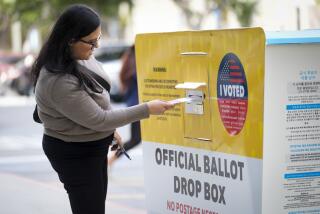Oxnard Drops Plan for Nov. 8 Referendum on Districting
- Share via
Discouraged by legal and administrative hurdles, the Oxnard City Council abandoned plans this week for a Nov. 8 referendum to do away with the city’s at-large election system.
Having persuaded county election officials to accept the measure, which was hastily conceived last week, city officials faced the unlikely prospect of convening the Ventura County Board of Supervisors before a ballot-printing deadline.
The supervisors, whose approval is necessary to add a measure to the ballot, are on vacation until Aug. 30. All but Supervisor John Flynn, whose district includes Oxnard, were out of town and unavailable for an emergency session, Councilwoman Dorothy Maron reported.
“I know when I’m licked,” said Maron, who last week proposed the move to eliminate an election system that has been criticized for allegedly discouraging minority representation on the council.
Petition Drive
The move was also intended to block a citizens group that has announced a petition drive to force a special election establishing councilmanic districts, in the wake of a recent federal court decision that forced one town to abandon its at-large system.
Maron had argued that tying the issue to November’s presidential election would draw more voters and spare the city the cost of a special election.
Meanwhile, the spokesman for the citizens group, Gilbert Beezley, said Tuesday that he plans to continue with the drive. However, his Council District Initiative Committee has yet to file petition papers with City Clerk Mabi Plisky, a necessary step before collecting signatures.
“We don’t see that there’s any light at the end of the tunnel,” said Beezley, an Oxnard paralegal.
City Atty. Gary L. Gillig and City Clerk Plisky painted a dour picture of Oxnard’s prospects.
Gillig said the city had “a less than 50%” chance of obtaining a court order forcing county supervisors to act on the measure at their next regularly scheduled meeting, which is Aug. 30. He predicted that a judge will side with Ruth Schelper, the assistant registrar of voters, who has maintained that adding the Oxnard measure would ruin a ballot-printing schedule designed to conform with strict state-mandated election deadlines.
And even if forced to convene, the supervisors would not necessarily do the council’s bidding, Gillig warned.
“I think that resorting to legal measures is self-defeating,” agreed City Councilman Manuel Lopez. “Human nature being what it is, they can put in all kinds of roadblocks. If you try to force someone to do something, they just won’t do it.”
Plisky, meanwhile, discouraged the council from holding a November vote on the measure separately from the county elections.
She said a Lakewood election-consulting firm had told her that the cost of the effort would be more than $30,000, which, she pointed out, was barely less that the $35,000 cost of conducting a special election. Arcane election codes would also dictate that most voting booths for Oxnard’s election be located in places other than the ones used in the presidential election.
Maron said that the plan would defeat the purpose of placing the measure before voters in the general election.
“We wouldn’t be doing what we set out to do,” she said, expressing disappointment. “Most people won’t go to two polls.”
Earlier Session
Added Mayor Nao Takasugi: “It’s hard enough to get them to go to one.”
The disappointing tenor of Tuesday’s meeting contrasted sharply with a special session last week. At the meeting, Gillig announced that he had persuaded the county counsel’s office to accept an interpretation of the state Election Code that would have allowed Oxnard two more days to file its ballot measure with the county.
City officials then worked past 11 p.m. dividing the city into six districts along boundaries proposed by the Council District Initiative Committee.
By the next day, however, the mood had soured.
Committee members charged in a press conference that council members had failed to close a loophole that would have allowed them to redraw districts with a five-member majority. The committee members, who say their drive is aimed at ousting incumbents, said that longtime council members could conspire to redraw the districts to preserve their seats.
They pointed out that four current council members who live in the same neighborhood could change district boundaries by a matter of mere blocks to retain their positions.
Suit Threatened
The group threatened to bring a lawsuit forcing the city to hold a special election in March to replace all council members if the districting measure passes in November. Gillig has said the Election Code prohibits districting efforts that affect the terms of incumbents. Committee members, meanwhile, maintain that the recent federal ruling takes precedent.
The flurry of activity followed a U.S. 9th Circuit Court of Appeals order forcing the farming town of Watsonville to abandon its at-large system in favor of a system that the court deemed more favorable for Latino candidates. A minority had not held office there in 15 years, despite a Latino population that constituted more than 48% of the town.
Supporters of councilmanic districts in Oxnard, where only three Latinos have served on the council despite a Latino population of at least 44%, argued that the Ventura County city closely resembles its San Luis County counterpart.
More to Read
Sign up for Essential California
The most important California stories and recommendations in your inbox every morning.
You may occasionally receive promotional content from the Los Angeles Times.










